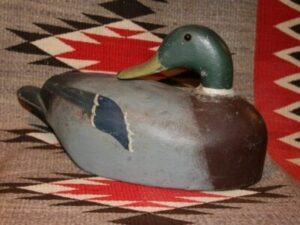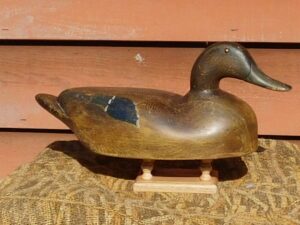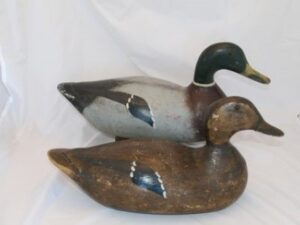A Decoy Corner Article
By Bruce Urben, WWA President
All photos courtesy Wisconsin Sporting Collectibles.
Horicon, WI was founded as a lumber mill town and a railroad hub on the Rock River in the late 1800’s. Horicon Marsh is located in south central Wisconsin, north of the Village of Horicon in southern Fond du Lac county and northern Dodge county. This silted up lake is one of the largest freshwater, cattail marshes in the United States at 33,000 acres. Horicon Marsh was an area rich in waterfowling history during the heyday of market hunting. It was the stopover for hundred of thousands of migrating waterfowl. Recently, the number of migrating waterfowl using Horicon has decreased, however the northern two-thirds of the Marsh is managed by the U.S. Fish and Wildlife Service as the 22,000 acre Horicon National Wildlife Refuge.
The good duck hunting at Horicon found many decoy carvers plying their trade and selling their work to market hunters as well as “sports” from the East and the West.
Burton “Burt” Lange was a native of of Horicon, born in 1896. He lived in the Horicon area most of his life, was an avid waterfowler and made very high quality decoys that were unique in style.
Lange was employed at the Vanbrunt manufacturing plant in Horicon. Vanbrunt became the John Deere factory in the later years and is still located on Vine Street in Horicon. They currently build utility tractors, riding mowers and Gator utility vehicles.
Very little is known about Lange’s family life. We know that he was married, divorced and remarried. He was a passionate waterfowler and was active in local civic activities. He was a leading participant in the “Horicon Liberation Day” in 1935 in the Marsh. This is where hundreds of domesticated waterfowl were released into the marsh, some say as a publicity stunt!
Lange’s decoys were very artistic compared to his contemporaries. Most of his carving was done in the 1930’s and he did all of his carving in the attic of his home as he never owned a garage or a car. Lange used old telephone poles for his decoy bodies. His decoys were full bodied, very well made and were considered “folksy”. His decoys were a little larger than lifelike, considered now as a magnum. Burt’s decoys have high heads and a protruding tail that was characteristic of his style. They are flat bottomed with a flat rectangular lead weight inset into the bottom.
Lange used a scratch painting technique on his mallards, giving the effect of feather detail, using subtle shading and blending of his oil paint to depict a life-like decoy. His bills were carved with detail; he used glass eyes that most felt were placed too high on the head. It is known that he carved exclusively mallard hens and drakes and colorful pintails. No other decoy species are known to exist.
It has been reported that Burt sold his decoys for $12 a dozen in the 1940’s and carved numerous rigs for his own use. It is estimated that he carved several hundred decoys in his lifetime. Locals reported that the best decoy in the area was made by Burt Lange.
Burt Lange passed away in 1967 at the age of 71.
Lange’s decoys are in high demand by Wisconsin collectors. His unique style and paint scheme is highly regarded. It is not uncommon to see his decoys selling for up to $1000 on the secondary auction market.
Although Horicon Marsh no longer attracts the large numbers of ducks as it did in the early 1900’s, the decoys used in the marsh during those golden years are a legacy in themselves. And, there is no question that Burton “Burt” Lange’s decoys were a very important part of the Horicon waterfowling legacy.



